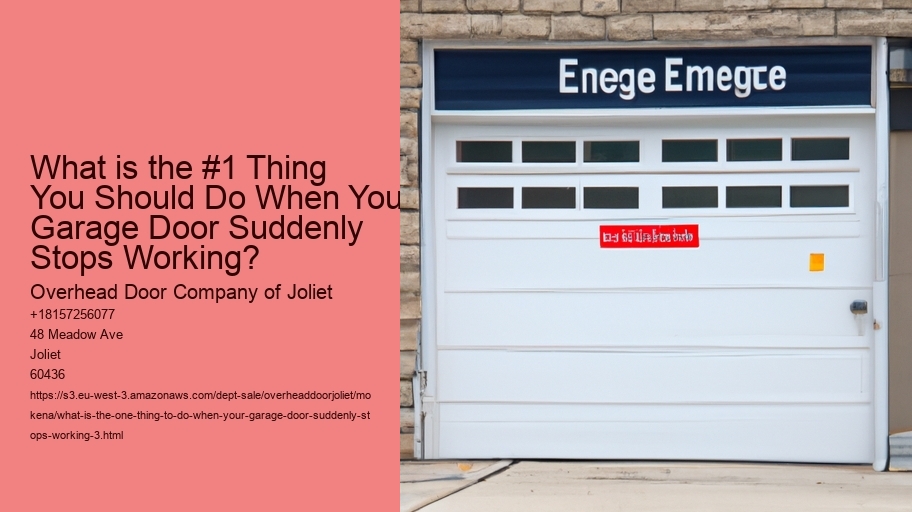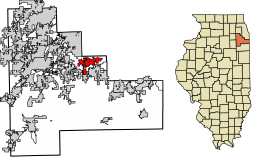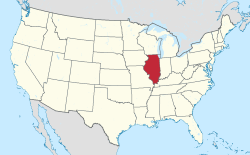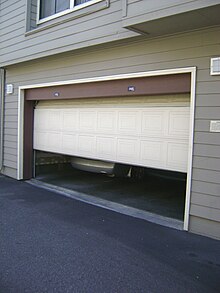Know the type of garage Door and Opener
When garage doors stop working, it can be an unsettling and unpleasant experience.Whether you are rushing out to work or trying to move your car to the garage after a heavy rain or storm, a door that isn't working is not something you would want to have to deal with.The first step to address this issue is to identify the type of opener and garage door you have, as this can greatly affect the way you approach solving the problem and fixing. What do you do should you do if your garage door suddenly stops working? .
Garage doors generally fall into a variety of types based on their appearance and operation.The most popular varieties are roll-up, sectional as well as tilt-up doors.Sectional doors are made of panels joined by hinges, allowing the door to bend when it opens and closes on an upright track.Roll-up doors, commonly found in commercial settings made from sections of wood that are rolled up into a coil.
Doors that tilt up, on the other hand, are a single solid piece that tilts upwards and outwards as it opens.Importantly, you must identify the kind of garage door opener.The three types of garage door openers include belt-drive and chain-drive and screw-drive openers.Chain-drive openers, which rely on an iron chain to raise and lower the door, are sturdy and economical but can be noisy.Belt-drive openers function similarly, however, they employ a rubber belt, making them quieter and an ideal choice for attached garages.Screw-drive openers operate with a threaded steel rod and offer a good balance of the noise and the cost.
The next step is checking your garage door opener and identify the type. Examine the breaker and plug to confirm that the opener is running. Examine the manual release cable and make sure that it's not pulled. This will cause the door to become removed from the opener. Review the rollers and tracks of the door for damage or obstructions and remove any debris.
If required, lubricate moving components. Insufficient lubrication could result in them becoming stuck or stick.If your door continues to not operate, consider resetting the opener.This can often resolve electronic malfunctions or faults.Consult the manual for your opener to find specific reset instructions as this procedure may differ for different models.Many modern openers come with reset buttons, however others may require unplugging and plugging back in.
In certain instances, the issue might be more complex, such as a broken spring or a worn-out motor that requires professional assistance.Springs are under a lot of tension and are dangerous to repair without the appropriate equipment and knowledge.
When the garage door stops functioning then it is
Be sure to look for any obstructions or debris
If your garage door suddenly stops working, it's extremely frustrating and confusing particularly if it's part of your routine.
One of the basic and most practical steps to take when faced with this situation is to search for obstructions or debris.This simple but effective step can be a key in identifying the issue and restoring the functionality of your garage door.Even a tiny obstruction can prevent your garage door from working as it should.
Start by looking at the tracks, both on the left and right side of the door. Find obvious obstructions, or debris accumulation. If you spot anything unusual, such as an acorn, or a rock stuck in the track. Take it out with care.
The issue may not always be apparent. To determine if the problem is still there, try running your hand down the track. Also, ensure that the tracks are aligned. This is because misalignment could also result in a jammed door.In the next step, examine the rollers as well as hinges.These parts should be able to move without resistance.If they are sticky or stuck, it might be a sign of accumulated dirt or rust.In these instances cleaning and lubricating them can often resolve the issue.Use a soft cloth or brush to remove any dirt, and apply a suitable lubricant in order to ensure smooth movement.
It's also vital to look over the area surrounding the door itself.Sometimes items stored in garages can move or fall, blocking the pathway of the door.Ensure that the area is clear and that nothing is blocking the door's motion.
Verify the sensors if the door is not opening after you have removed any obstructions.
The sensors in modern garage doors may fail when they're dirty, or if they are not aligned correctly.If you are confronted with an garage door that suddenly isn't working, looking for debris or obstructions is a reasonable and often successful first step.It will require only a few tools and know-how, but it will save you money, time as well as the inconvenience of contacting a professional for the most straightforward fix.By maintaining a clear path and
Check the wall switch and remote control
If the garage door stops functioning or is not working, it's an unexpected inconvenience that disrupts your daily routine.In such instances there is a natural feeling of an urgency to resolve the issue quickly.One of the initial and most effective steps you could take is to look at the remote control and wall switch.
The inspection of these components can help you save time and avoid costly errors.First, consider the remote control.This handheld device is your primary tool for operating the garage door without direct physical interaction.Over time, remote controls can experience issues such as drained batteries, signal interference, or even internal damage.Start by replacing the batteries with new ones.It might seem simple, but dead batteries are a common reason for a garage door not responding.If the problem persists after replacing the batteries, try reprogramming the remote according to the manufacturer's instructions.Additionally, ensure that the remote is within the recommended range and that there are no obstructions blocking the signal.
The wall switch is also a critical component of the garage door's installation.
If you're comfortable then open the switch panel to check for broken or missing wires.What is the One Thing to do when your Garage Door suddenly stops working? - HomeAdvisor
- fee
- HomeAdvisor
- Republican Party
In certain instances, the remote control and wall switch could appear to be functioning properly, yet the door remains unresponsive.This could be a sign of a problem in the garage door opener unit itself or other components such as the sensors or the door tracks.However beginning by utilizing the wall switch and remote control would be a sensible first step.
You can resolve these issues before moving on to more intricate troubleshooting.To conclude, checking the wall switch and the remote control in the event that your garage door stops working is a straightforward and efficient approach.By addressing these components first, you'll quickly identify if the issue is within these easily accessible parts or if additional examination is needed.This initial examination not only saves time but also provides peace of mind knowing that you have taken the proper steps to determine the issue correctly.
Test the door balance manually
It's frustrating and a hassle when the garage door ceases functioning. Garage doors are a vital part of your house, as it offers security, protection against the elements, and easy access to your car as well as storage.
The first step you must make when confronted by the problem of a garage door that is not working is to manually test the door's balance.This simple but effective method can assist in identifying potential issues and avoid further damage to the door or its parts.The balance of a garage's door is crucial for the proper functioning.A balanced door will ensure that the door opener does not require more effort than it has to, reducing the risk of wear and wear and tear on the motor, as well as other parts.An unbalanced door, contrary to what you might think can cause significant problems over time, including misalignment, broken springs, or complete system failure.Therefore conducting a test of the door's balance is a vital diagnostic step that can help you determine whether your issue is related to the door or the opener mechanism.
Start by disengaging the garage door opener.
The majority of garage doors are equipped with a release system that is located on the handle or red cord. Once the door has been disconnected from the motor lift it to waist-high and let it go. A well-balanced door will remain in place and move slowly.It is best to consult professionals to help adjust the springs to ensure that your garage door is balanced. This is not just going to resolve the issue but will also improve the life and efficiency of your system.
In the end, testing manually the door balance is an essential first step to take when your garage door stops working suddenly.
This procedure helps to determine whether the problem lies in the door's balance or somewhere else within the system.By knowing the importance of balancing your door and taking care to address any issues quickly you will be able to avoid any further damage and ensure that your garage door runs without issue and in safety for the years to be.Review the Tracks and Rollers.
When you're faced with a garage door that has suddenly stopped to operate, your first response is to worry or consider the most difficult technical issues.However usually, the solution is in a straightforward inspection of the tracks and rollers.This essential check will save you time and potentially costly repair costs, making it the one thing you should prioritize when your garage door stops working.
The tracks and the rollers of your garage's operational system are essential. The tracks comprise the metal rails that control the door when it opens, and the rollers run through the tracks.
The parts may wear out, become dirty or misaligned as time passes. This can cause issues with operation.Start by inspecting the track for any obstructions. Dirt, grime, and even tiny particles can accumulate, causing rollers to struggle to travel along the path. Cleansing the tracks with an aqueous cloth will resolve this issue.
After that, you should check the alignment of the tracks.Tracks should be perfectly straight and parallel to each other.If they appear bent or not in alignment, your door may jam.You can gently tap the misaligned portions back into alignment using an rubber mallet.However when the damage is extensive then it is recommended to seek out a professional for help to align them properly to ensure safety and functionality.
The wear and tear of rollers can occur with time. This is particularly true for those made of plastic.
Metal rollers that have bearings are more durable, and provide an easier operation.Applying silicone-based oils can help reduce friction and wear. Make sure you lubricate the hinges and springs in order to ensure that your garage door is functioning properly.
By ensuring that these components are well-lubricated and aligned It is possible to get the garage door back to its complete functionality.
The time taken to check and maintain regularly these components can help prevent further malfunctions, which can extend the life span of your garage door's system.Look for obvious damage or wear
When garage doors stop functioning, it could be extremely frustrating and inconvenient, particularly if you are going out or attempting to secure your home for the evening.While there could be many causes for the problem, one of the most practical and immediate steps to take is to search for signs of damage or wear.This initial inspection is likely to determine the root of the issue, making to find a swift and efficient solution.
Garage doors are complicated systems which include rollers, springs, tracks, cables and other components. As time passes, the components of this system could become worn-out due to daily use and the exposure.
You can easily identify evident damage when you perform an examination of the area.Start by looking at the springs, which are critical to the lifting and lowering of the door.Look for any signs of corrosion, damage or misalignment.A damaged or worn-out spring can render the door unusable, and it is crucial to take care of this issue promptly.Next you should look at the cables, and be sure to check for damaged or frayed wires that might hinder the door's movement.Similarly look over the rollers and tracks for any debris, dents or obstructions that might cause obstructions to the door's passage.
The door is another area that needs the attention of a professional. Be aware of visible damage, warping or bends.
Also, make sure that the door's sensors are clean and aligned as misalignment or dirt may interfere with their functions and cause the door to stop functioning.A visual inspection is beneficial however it's essential to be aware that not every issue is immediately apparent. If you don't notice any obvious evidence of wear or damage you may need to consult with a specialist to pinpoint the issue.
This approach will not only help you identify the problem more quickly, but it will help you take steps to repair the proper functioning of your garage door.
You can extend the lifespan of your garage door simply by being proactive.Check the Springs and Cables
It's frustrating to find your garage door not functioning.
What is the One Thing to do when your Garage Door suddenly stops working? - Republican Party
- Cairo
- Kaskaskia
- Midwestern United States
Springs play a crucial function in the operation of your garage door, providing a balance to the door's weight.When the door is in motion the springs carry the majority of the weight and allow the door to be opened and closed smoothly.There are generally two kinds of springs: the torsion and extension springs.Torsion springs are placed above the garage door, and they twist to store energy, whereas extension springs are mounted to both sides of the door and extend to give the needed force.
These springs are prone to wear out over time, break or lose tension causing problems in operation.The cables could be damaged by wear and tear. They can fray or snap under pressure.
If you're not sure whether the springs or cables need to be adjusted, visually look them over. Examine for signs of wear and rust.
Safety is paramount when dealing with garage door components.
The springs and cables are in tension and can cause serious injuries. If you do not have any experience with garage repair, it's best to call an expert. They'll have the tools and experience required to safely fix or replace these parts. This will ensure that your garage door functions in a safe and efficient manner.In conclusion, when your garage door suddenly stops working, assessing the springs and cables is a key step in diagnosing the problem.Understanding their role and potential issues can help you determine whether a simple adjustment is needed or if professional intervention is required.Taking prompt action not only restores functionality but also ensures the safety and longevity of your garage door system.
You Need to Call a Professional Technician
When your garage door stops working and it is not working, it could disrupt your day and even pose the risk of a security threat to your home.
It may be tempting to grab a toolbox to try a fix on your own however it is better to seek out a professional. This decision is not just about your safety, but provide a long-lasting and more effective solution.What is the One Thing to do when your Garage Door suddenly stops working? - fee
- pulley
- Illinois
- customer service
Garage doors are complex systems composed of various components such as springs, cables, tracks, and electronic parts.Each of these elements plays a crucial role in the door's operation, and a malfunction in any part can cause the entire system to fail.Without proper knowledge and experience, attempting to fix these issues can be dangerous.For instance, garage door springs are under high tension and can cause severe injury if handled improperly.Professional technicians are trained to deal with these risks safely, using the right tools and techniques to handle repairs.
Additionally, a professional technician provides expertise and experience a layperson simply does not possess.
They can quickly diagnose the issue and identify whether it's a minor problem, like a misaligned track, or something more serious, like a broken spring.This expertise not only saves you time but also prevents the potential for further damage that can occur with incorrect handling.Professionals also have access to high-quality parts and can ensure that replacements match the specifications of your existing garage door system, leading to better functionality and longevity.A professional technician may be cost-effective over the long-term. Although an DIY option may appear cheaper at first but, it could end up resulting in more costly and extensive repairs later on.
Many technicians also provide guarantees on their work, which gives you peace of knowing that should something go wrong, you are covered.Calling a professional will reduce time and cost. If you are trying to learn the mechanism behind garage doors, purchase the appropriate tools and complete repairs can take some time or even days. A professional can fix the issue quickly and enable you to go back to normal.
While the desire to fix your garage door on your own may be overwhelming, a call to a professional technician is the most secure option, the most efficient, and ultimately the most sensible option.Their skills, experience, access to quality parts, and the ability to carry out quick and precise repairs will ensure that your garage door is up and running again safeguarding your home and your valuables.


















